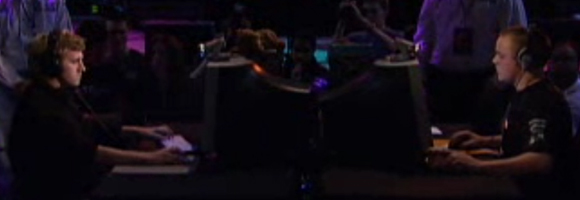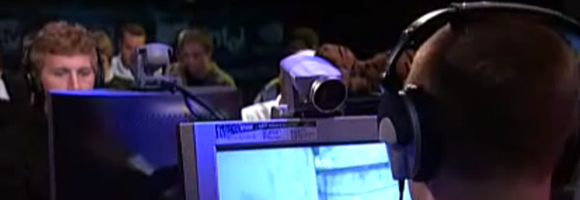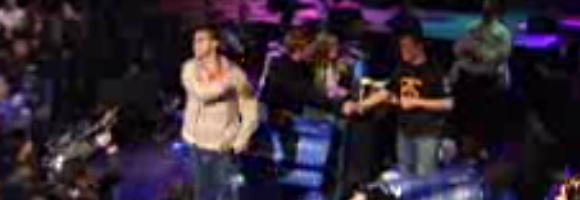world’s greatests—cpl world tour 2005 finals
a cyberanthropologist’s reflections on e-sports

At a tremendous pace computergames and gaming-culture get more and more attention and coverage by ‘traditional’ electronic and print mass media. More and more institutions of said media take computergames to be a serious and worthwhile topic. A sure sign for them becoming integrated into mainstream contemporary culture, loosing the air of an initiated-youths-only subcultural thing. Simultaneously media-coverage of game-issues step by step drifts away from the purely negative and dystopian towards the more differentiated and sometimes utterly positive.
As mainstream contemporary culture is embedded into a transnational economical system, this spreading of the gaming-culture word has to be backed up and driven by substantial economical interest and motivations. In order to come into being, and to spread over the globe, the culture of the Internet and the Internet-infrastructure itself needed—among other things—a layer of money-driven entrepreneurs. (↵Castells 2001b, see ↵history, generations, the Internet, and cyberculture, too) In almost the same manner computergames need the attention of a ‘big-corporations-and-mass-media’ cultural layer to become a mainstream global societal and cultural issue. Maybe this layer is what became of what Castells identified as the entrepreneurial cultural layer, which played a decisive role in the formation of the Internet.
One of the strongest contemporary factors which is able to draw this layer’s attention onto computergames is a cultural stance which emerged out of gaming-culture: the notion of ↑e-sports. Within this very notion—playing computergames to be competitive sports—lies the possibility to make computergames a multi-million business within ‘traditional’ mass media. Only that way computergames can become recognized and accepted by the global cultural mainstream, can become an integral part of the latter. Just as it happened with offline professional sports at large and in particular. I am especially thinking about boxing.
Just like it is the case with boxing, there are several international umbrella organisations taking care of e-sports, like the ↑Electronic Sports League or the ↑World Cyber Games. But the initial and maybe most forceful thrust for e-sports stems from the ↑Cyberathlete Professional League (CPL).

For this year’s CPL world tour the game ↑Painkiller (PK) was chosen. The final bout between professional gamer legend [see ↵world’s greatest, and ↵fatal1ty on air] ↑Jonathan Wendel aka ↑Fatal1ty (24 years young) and The Netherlands’ gamer top-star ↑Sander Kaasjager aka ↑fnatic.↑Vo0 (20 years young) took place on 22nd November at the Nokia Theater in Times Square, New York City, and started at 17:40EST that day. “For the first time ever, over 200 international media organizations have reported on the finals of an esports tournament.” E.g. Forbes, CNN, NY Daily News, BBC, Washington Post and many more ran reports. (↑Media Reports on CPL World Tour Finals) Furthermore MTV broadcasted the event live on air and on the Internet. Get and watch the ↑whole MTV coverage of the final match Fatl1ty vs. Vo0 [01:50:07hrs | .asf | 536MB] and find out who won and how.
Of course within the gaming community the event is discussed controversially: There is criticism against Fatal1ty’s ‘defensive style’ of playing, against the live comments of the MTV-commentators, and many more issues [btw guys’n’gals: below is the definitive proof that Fatal1ty and Vo0 indeed shook hands after the match ;-]. But in my view it is definitely worthwhile to rewatch, especially for those having little or no idea about gaming culture, first-person shooters (↵FPS) and e-sports in particular. Besides all the critique against Painkiller, the game indeed replicates the ‘old-school FPS’ gameplay and ambience of ↑Doom, ↵Q3A and the likes. Watching Fatal1ty vs. Vo0 impressively gives an idea of the sheer speed of games like that—gamers of that calibre clearly dwell in another dimension regarding perception, action, and reaction. If one has no own experience in playing FPSs one simply is not able to follow the action displayed. The sports-reporter-style live comments are not a nuisance but actually explain what is going on and give an idea of how deeply strategy and tactics are involved—matches like that clearly go way beyond skill, precision, and speed of reaction. Those are prerequisites, mastering the actual game is not a mere demonstration of hand-eye-coordination wizardry. At one point a commentator remarked: “Now it’s a game of chess,” which very accurately, although metaphorically, described the current situation within the match.
Chess itself is not a big hit on TV and other synchronous/real-time mass media because it lacks the action-appeal, and because in order to be able to understand and embrace what happens on the chequerboard when two grandmasters are battling, one needs to be initiated into the game quite deeply. By definition first-person-shooters possess a tremendous potential of action-appeal. But, just as it is true for chess [but not for e.g. track & field or the olympic games at large], to understand and embrace e.g. Fatal1ty vs. Vo0 you need to be initiated into first-person-shooters yourself. Initiated are the members of the transnational gaming-community. The latter’s rank and file are absolutely large enough to motivate the corporate/mass media layer to pay attention to computergames and to invest into the phenomenon. Additionally the gaming-community culturally ↑pwnz [I beg your pardon for the cheap pun] the Internet—which obviously is of vital, or even virulent interest to said layer—as its homeland.


